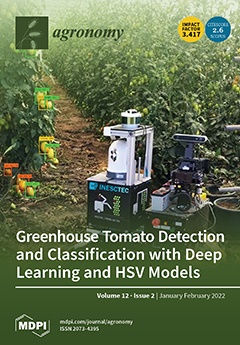View Item
- xmlui.general.dspace_homeCentros Regionales y EEAsCentro Regional Buenos Aires SurEEA BordenaveArtículos científicosxmlui.ArtifactBrowser.ItemViewer.trail
- DSpace Home
- Centros Regionales y EEAs
- Centro Regional Buenos Aires Sur
- EEA Bordenave
- Artículos científicos
- View Item
Increased Nitrogen Retention and Reduced Methane Emissions of Beef Cattle Grazing Legume vs. Grass Irrigated Pastures in the Mountain West USA
Abstract
Grazing studies were carried out over a 5-year period using pregnant cows, yearling calves and 2-year-old heifers to investigate the influence of diet on intake, methane (CH4) emissions and retention of nitrogen (N). Monoculture legume (birdsfoot trefoil, BFT and cicer milkvetch, CMV) or grass (meadow bromegrass, MBG) pastures were rotationally stocked, and during year 4 and year 5, treatments were contrasted with total mixed rations (TMR) fed in
[ver mas...]
Grazing studies were carried out over a 5-year period using pregnant cows, yearling calves and 2-year-old heifers to investigate the influence of diet on intake, methane (CH4) emissions and retention of nitrogen (N). Monoculture legume (birdsfoot trefoil, BFT and cicer milkvetch, CMV) or grass (meadow bromegrass, MBG) pastures were rotationally stocked, and during year 4 and year 5, treatments were contrasted with total mixed rations (TMR) fed in confinement. The sulfur hexafluoride (SF6) method was used to continuously measure enteric CH4 emissions. Intake was greater on legume pastures and on TMR than on grass pastures, and enteric CH4 emissions per unit of intake were lower on legumes compared with grass pastures. Legume pastures had elevated non-fiber carbohydrate (NFC) concentrations (400 g kg−1 dry matter; DM) typical of perennial legumes cultivated in the Mountain West. A N balance calculated in 2017–2018 demonstrated that N retention was greater for TMR and legume than grass pastures. Enteric CH4 emissions of grazing cow herds account for the majority of greenhouse gas (GHG) emissions from beef production and can be significantly reduced by using highly digestible forage legumes. The N retention of legumes can potentially enhance the efficiency of N use, thereby increasing the sustainability of grasslands.
[Cerrar]

Author
MacAdam, Jennifer W.;
Pitcher, Lance R.;
Bolletta, Andrea Ivana;
Guevara Ballesteros, Raúl David;
Beauchemin, Karen A.;
Xin, Dai;
Villalba, Juan J.;
Fuente
Agronomy 12 (2) : 304 (January 2022)
Date
2022-01
Editorial
MDPI
ISSN
2073-4395
Formato
pdf
Tipo de documento
artículo
Palabras Claves
Derechos de acceso
Abierto
 Excepto donde se diga explicitamente, este item se publica bajo la siguiente descripción: Creative Commons Attribution-NonCommercial-ShareAlike 2.5 Unported (CC BY-NC-SA 2.5)
Excepto donde se diga explicitamente, este item se publica bajo la siguiente descripción: Creative Commons Attribution-NonCommercial-ShareAlike 2.5 Unported (CC BY-NC-SA 2.5)


